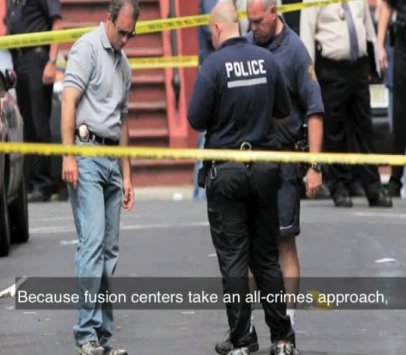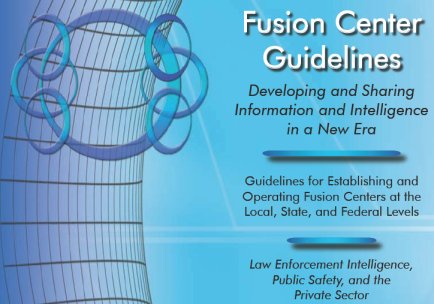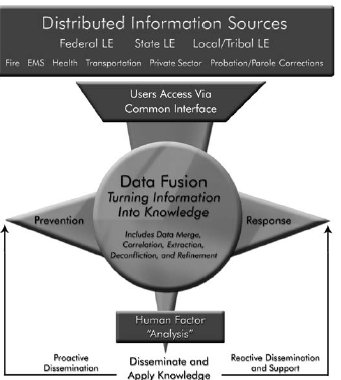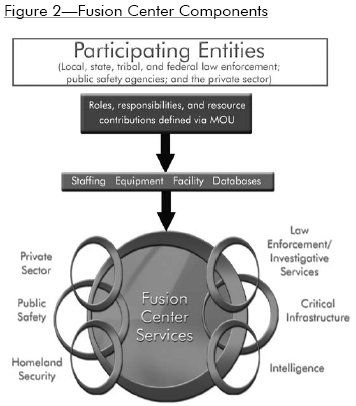The snapshot image to the right was taken from a video posted on the NFCA website. It can also be viewed on youtube to make the captions easier to read.


Homescam Unveiled
Yesterday in my inbox, there was an email there was a link to a Fox News clip with Shepard Smith and Judge Andrew Napolitano talking about Fusion Centers: Fusion Centers are a Scam.
The report they were talking about is dated October 3, 2012 so either the Senate delayed it's release or Fox News just found it. There was a report that was released by the GAO dated April 2013, but it wasn't nearly as interesting as the 2012 report:
Federal Support for and Involvement in State and Local Fusion Centers (PSI Report)
Admittedly, the report does have some belly laughs in it like the terrorist-shoplifter stealing shoes from Neiman-Marcus and the two guys suspiciously fishing in a place where nobody else fishes, but overall, the report is the same old story: incompetent and wasteful bureaucracy, overlapping agencies involved, misuse of funds, no oversight. Not surprisingly, it skirts and/or completely misses what should have been the real story.
At various times in Congressional Hearings and other places, the Fusion Centers program has been described as "one of the centerpieces of our counterterrorism strategy" and "a major force multiplier in the counterterrorism enterprise" and that they were to be data collection points for terrorist and potential terrorist activities. At other times, Janet Napolitano described the fusion centers as "part of the Department's counterterrorism efforts, and also as centers which do 'everything else'". Page 16 (22) It would seem that the "everything else" is more accurate because the FBI has had a Joint Terrorism Task Force (JTTF) since 1980.
At the time the PSI report was prepared, there were 68 Fusion Centers and not one of them had produced a credible report on terrorist activities anywhere. Their one major accomplishment seems to be that they organized an association to represent them and to lobby for more money from Congress. The National Fusion Center Association has a website. On the front page - right hand side, is their response to the PSI report. The following paragraph regarding a 2010 Assessment Report that DHS first denied existed and then resisted giving a copy to the Committee is more than a little disturbing:
"DHS eventually produced the “report cards” on individual fusion centers and the final 2010 assessment report to the Subcommittee after obtaining “consent” from a private, nongovernmental organization, the National Fusion Center Association (NFCA), which supposedly had the authority to represent the 68 fusion centers subject to review. In a letter to the Subcommittee, NFCA explained it had “authorized” DHS to share the assessment information with Congress." Page 87 (93).
|
The snapshot image to the right was taken from a video posted on the NFCA website. It can also be viewed on youtube to make the captions easier to read. |
 |
|
 |
||
Before 2008, the DHS provided Fusion Center funding through it's Law Enforcement Terrorism Prevention Program (LETPP) which no longer exists as a separate program. Page 24(30) The DHS now provides grant funding for Fusion Centers through several of its agencies and offices but primarily through FEMA for "building and sustaining national preparedness capabilities):
"DHS funds state and local fusion centers through its Federal Emergency Management Agency (FEMA) grant programs. DHS provides information, logistical support, technology and personnel to the centers through its State and Local Program Office (SLPO), part of its Office of Intelligence and Analysis (I&A). DHS personnel also draft intelligence reports based on information received at fusion centers, which the agency then processes for release through its Reporting Branch (RB), also a part of I&A." Page 6 (12)
There is no accurate accounting for the money spent, but the report says between 2003 to 2011, between $289 million and $1.4 billion. That number has to be a gross underestimate because in another place in the report, it says that FEMA distributes $800 million among the states annually. Whatever the number, what the taxpayers get for it (because 24/7 police state surveillance) is:
In interviews, current and former DHS officials involved in the fusion center reporting process stated they were aware that “a lot of [the reporting] was predominantly useless information,” as one DHS official put it.4 A former reporting branch chief said that while he was sometimes proud of the intelligence his unit produced, “There were times when it was, ‘what a bunch of crap is coming through.’” Page 3 (9)
And it's no mystery why the information would be crap when you consider this:
DHS required only a week of training for intelligence officials before sending them to state and local fusion centers to report sensitive domestic intelligence, largely concerning U.S. persons.
Officials who routinely authored useless or potentially illegal fusion center intelligence reports faced no sanction or reprimand.
If nothing else, the 2012 Senate Report proves that at least some - probably most members of Congress have no idea what the government is actually doing. The testimony given by people like DHS Secretary Janet Napolitano mislead or misinform Senators and Representatives and there is more than enough documentation to support that allegation. In 2005, the U.S. Justice Department's Global Justice Information Sharing Committee published a Fusion Center Guidelines report that detailed the intent of the Fusion Center Program. There is a disclaimer that the opinions expressed are those of the authors, but that disclaimer is meaningless in published reports produced for government agencies. If the report didn't represent the views of the agency, it wouldn't see the light of day.
The following is an excerpt from the Guidelines report with highlights added:
What Is the Fusion Process?
The concept of fusion has emerged as the fundamental process to facilitate the sharing of homeland security-related and crime-related information and intelligence. For purposes of this initiative, fusion refers to the overarching process of managing the flow of information and intelligence across all levels and sectors of government and private industry. It goes beyond establishing an information/intelligence center or creating a computer network. The fusion process supports the implementation of risk-based, information-driven prevention, Because of the privacy concerns that attach to personally identifiable information, it is not the intent of fusion centers to combine federal databases containing personally identifiable information with state, local, and tribal databases into one system or warehouse. Rather, when a threat, criminal predicate, or public safety need is identified, fusion centers will allow information from all sources to be readily gathered, analyzed, and exchanged, based upon the predicate, by providing access to a variety of disparate databases that are maintained and controlled by appropriate local, state, tribal, and federal representatives at the fusion center.
Ideally, the fusion center involves every level and discipline of government, private sector entities, and the public—though the level of involvement of some of these participants will vary based on specific circumstances. The fusion process should be organized and coordinated, at a minimum, on a statewide level, and each state should establish and maintain a center to facilitate the fusion process. Though the foundation of fusion centers is the law enforcement intelligence component, center leadership should evaluate their respective jurisdictions to determine what public safety and private sector entities should participate in the fusion center. To aid in this assessment, functional categories have been developed, in which similar entities are grouped. These categories are not comprehensive but represent a starting point for fusion center leadership to begin assessing what agencies and organizations should be involved in the center’s operations.
The
functional categories include:
|
 This document was prepared under the leadership, guidance, and funding of the Bureau of Justice Assistance (BJA), Office of Justice Programs, U.S. Department of Justice, in collaboration with the U.S. Department of Justice’s Global Justice Information Sharing Initiative and the U.S. Department of Homeland Security. |
Global Justice Information Sharing
Global Justice Information Sharing Initiative is a Federal Advisory Committee working for the U.S. Department of Justice. Their committee is called the Global Advisory Committee (GAC) From their website:
Global is a ''group of groups,'' representing more than 30 independent organizations, spanning the spectrum of law enforcement, judicial, correctional, and related bodies. Member organizations participate in Global with a shared responsibility and shared belief that, together, they can bring about positive change by making recommendations and supporting the initiatives of the U.S. Department of Justice (DOJ)....GAC's efforts have direct impact on the work of 4 million justice and public safety professionals and positions Global to impact citizens of the United States, Canada, and beyond.
The GAC includes agency executives and policymakers, automation planners and managers, information practitioners, and, most importantly, end users. This last group distinguishes GAC as a committee whose members remain actively dedicated to information sharing because they continue to be producers, consumers, and administrators of crucial justice-related data. GAC membership reflects the tenet that the entire justice community must be involved in information exchange. Experts represent the following constituencies:
- Law enforcement agencies
- Prosecutors
- Public defenders
- Courts
- Corrections agencies
- Probation and parole departments
- Additional agencies directly involved in the justice process
The significance of the GAC being a "group of groups" combined with the description above that their intent is not to collect all data into a single data warehouse and rather to provide access to a variety of disparate databases on demand allegedly for cause, IS Total Information Awareness. That's what it was - a database of databases with their access information. I wrote about it after watching a Congressional Hearing on Homescam Security in 2007. The title hints at my annoyance :)
So while the Faux News reporter Shepard Smith and Andrew Napolitano were chuckling at the "terrorist reports" and clucking their tongues about the "potentially up to a billion dollars" wasted, they should have been talking about the fact that every agency of government is building databases and they are using grant money to fund the development of data collection through every state and local agency centralized in the Fusion Center collection points to provide the databases for the Total Information Awareness system: database of databases.

Fusion
Center Guidelines Page 18 Adobe

It should be obvious, but I'll say it anyway. The kind of power that this system gives to bureaucracies engaged in government and most especially to law enforcement is absolute, totalitarian power. It is the power to destroy good and decent people who get in the way and it is the power to put criminals into positions where they don't belong. The controllers of the information will be the masters of the universe. The Congress attempted to put a stop to this system in 2003. It still wasn't stopped in 2007. And today, in 2013, it rolls on unabated.
Vicky Davis,
Computer Systems Analyst
April 8, 2013
P.S. Mittens Romney was a member of the GAC Committee documented in the Foreword of the Fusion Center Guidelines Report. Janet Reno chartered the GAC in 1998 according to the White Paper on their website.